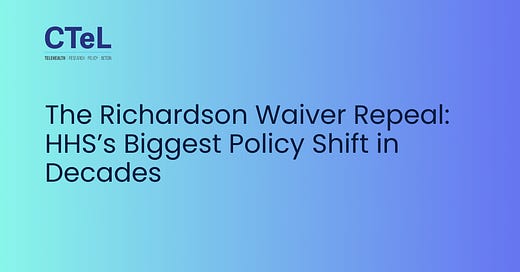The Richardson Waiver Repeal: HHS’s Biggest Policy Shift in Decades
How the 2025 Policy Change Reshapes Federal Rulemaking and Public Input
In a move with sweeping policy implications, Health and Human Services (HHS) Secretary Robert F. Kennedy Jr. has repealed the long-standing “Richardson Waiver,” a decision that could alter how HHS sets policies on grants, contracts, and benefits. The March 3rd, 2025, policy statement removes the agency’s self-imposed requirement to seek public input on certain regulatory actions, raising concerns about transparency and public engagement in the rulemaking process.
What Is the Richardson Waiver?
The Richardson Waiver originates from a 1971 HHS policy titled “Public Participation in Rule Making.” It directed the agency to voluntarily apply notice-and-comment rulemaking to issues where it was not legally required, including agency management, federal benefits, contracts, and grants. The waiver was based on a 1969 recommendation from the Administrative Conference of the United States, aiming to enhance public participation in shaping federal health policies.
Named after then-HHS Secretary Elliot L. Richardson under President Richard Nixon, this waiver expanded transparency and accountability in how HHS administered trillions of dollars in federal funding and benefits. For over 50 years, it has shaped agency decision-making and has even been referenced in court cases challenging HHS policies. Efforts to repeal it have surfaced periodically, including a 2016 American Bar Association position statement, but the policy remained intact—until now.
The 2025 Repeal: Why It Matters
The policy reversal by the Biden-Trump Administration signals a major shift in regulatory approach. The repeal allows HHS to bypass public comment periods on select administrative actions, accelerating decision-making on grants, contracts, and benefits. However, it does not eliminate public input on all rulemaking—statutory requirements under the Administrative Procedure Act (APA) will still apply where legally mandated.
Key Implications:
Federal Grants & Methodology Changes: HHS oversees the largest federal grant portfolio, distributing funds through the National Institutes of Health (NIH), Centers for Disease Control and Prevention (CDC), and other agencies. Under the repeal, methodology changes in grant allocations could occur without stakeholder feedback.
Benefit Program Eligibility: Programs such as Medicaid, the Children’s Health Insurance Program (CHIP), and the Supplemental Nutrition Assistance Program (SNAP) may undergo eligibility or administrative adjustments without the usual public comment periods.
Federal Contracts: Procurement processes, such as those for medical supplies and emergency response equipment, could see faster regulatory decisions but less external oversight.
What Won’t Change:
Medicare Payment Rules: The repeal does not affect routine annual updates, such as the Medicare Physician Fee Schedule (PFS) and the Outpatient Prospective Payment System (OPPS), which are legally bound by APA rulemaking procedures.
Coverage Determinations: National coverage decisions issued by the Centers for Medicare & Medicaid Services (CMS) remain subject to Section 1862(l)(3) of the Social Security Act.
Loan Repayment Programs: Programs like the National Health Service Corps and Indian Health Service loan repayment initiatives will continue under existing rulemaking standards.
Legal & Political Fallout: What Comes Next?
The repeal is already drawing scrutiny from legal experts and policymakers. HHS has historically relied on public comments to strengthen regulations and preempt legal challenges. With this change, courts may see an uptick in lawsuits arguing that impacted stakeholders were denied due process in agency decisions. The 2020 reaffirmation of the waiver by the Trump Administration also complicates the political landscape, as it marks a stark departure from the administration’s previous stance on regulatory transparency.
For industry leaders, the repeal signals a need for increased vigilance in monitoring federal rulemaking. Hospitals, vendors, startups, and virtual care providers should be prepared to engage in advocacy efforts and seek alternative pathways to influence policy decisions.
Conclusion: The Future of Public Participation in Healthcare Policy
While the repeal of the Richardson Waiver removes a decades-old transparency measure, its full impact remains uncertain. The policy shift grants HHS greater flexibility but raises concerns about reduced public engagement in decisions affecting billions in federal healthcare funding. As legal challenges and legislative debates unfold, CTeL will continue to monitor developments and provide updates on how stakeholders can navigate this evolving regulatory landscape.
For the latest policy insights and advocacy opportunities, visit www.ctel.org or contact us at info@ctel.org.




